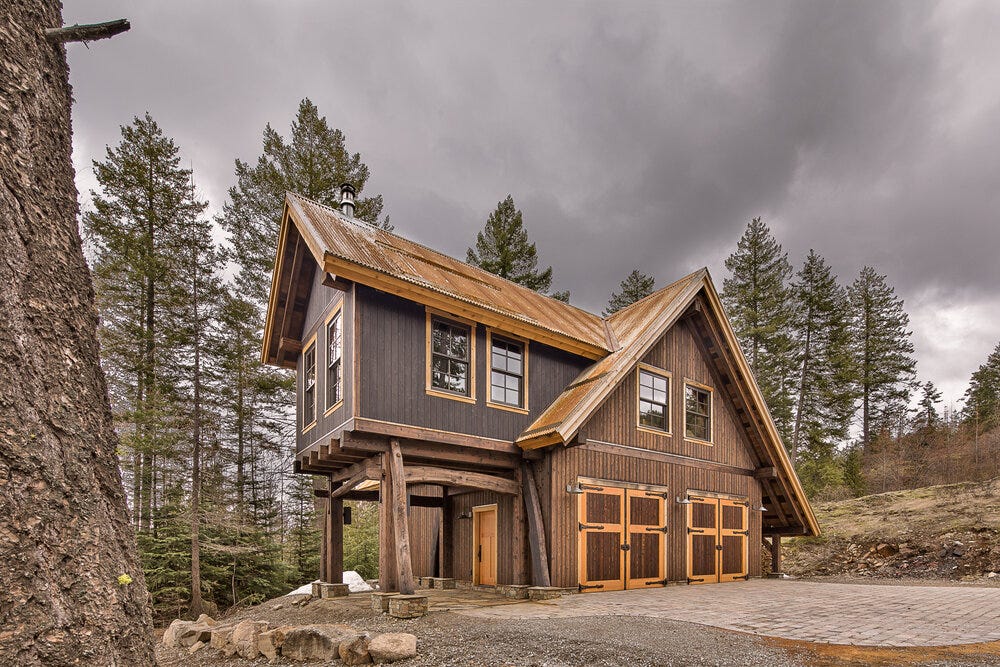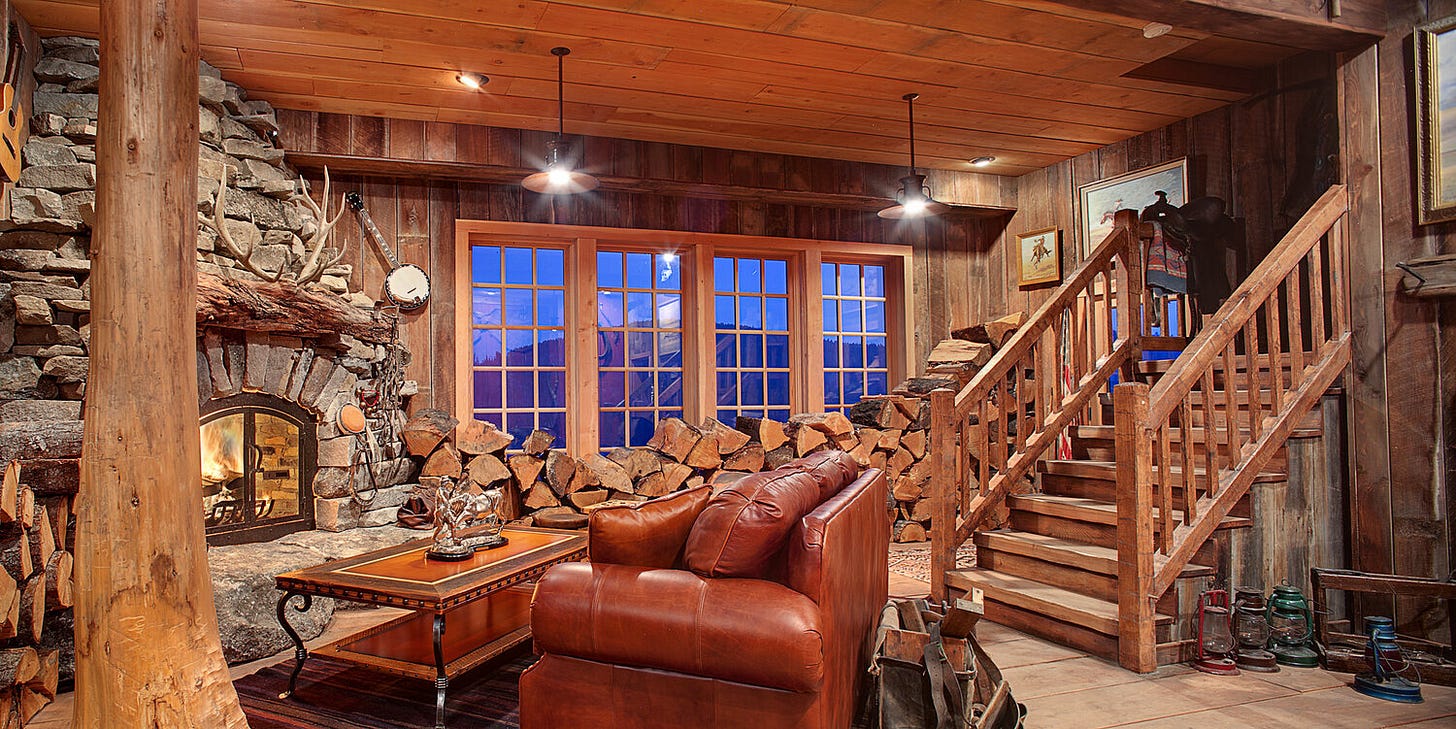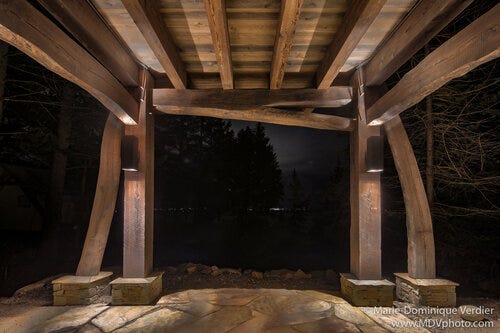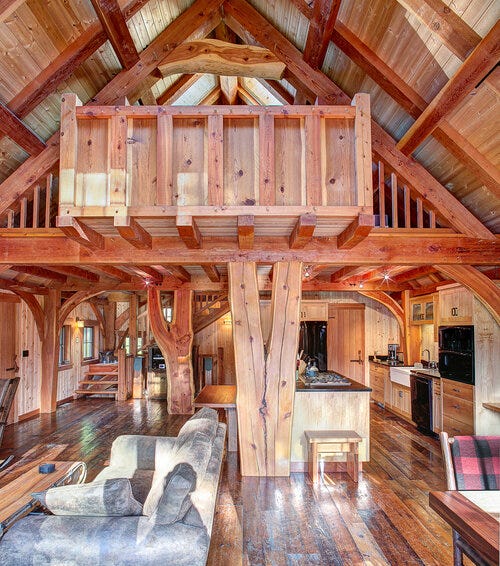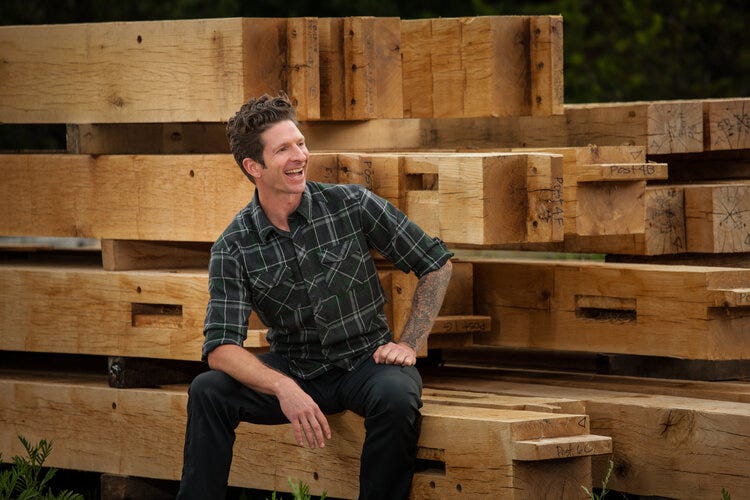It is not so much for its beauty that the forest makes a claim upon men’s hearts, as for that subtle something, that quality of air that emanation from old trees, that so wonderfully changes and renews a weary spirit.
― Robert Louis Stevenson
Sitting down to write, I begin by acknowledging the directions. All the cardinal ones, above and below, outside and in. Acknowledging where I exist in relation to my environment helps me create a container for my energy and mind. This container is spacious and void of distractions. It helps me feel calm and centered. Settling into this space, I notice that it has the same quality of feeling that I get when sitting with images of Collin Beggs' timber frame homes.
A designer and a master builder, Collin Beggs has been studying the art and craft of timber framing for more than two decades. Working out of Sandpoint Idaho, on the traditional territory of the Kutenai, Collin creates homes that are equal parts luxury wilderness lodge, cozy cabin, and old growth forest. Trained in the traditional timber framing techniques of English and Welsh medieval carpentry, and influenced by Japanese Minka farmhouses and Shinto style temples, Collin and his team have a deep respect for the lineage of their craft. Each builder is highly trained in working with traditional hand tools and each is intimately acquainted with the materials they work with. This allows each tree species to be celebrated for its unique strengths. Using the least processed materials with the highest skilled labor is the keystone of the company.
Drawing inspiration from the land that each home is built on, Collin curates timbers that have either come directly from the home site or have been locally sourced over many years. Different species of trees are used and are incorporated into the design in such a way as to have their unique character expressed. Finishes are chosen that showcase grain and fragrance. Burning, oiling, hewn and hand-planing techniques all give attention to the details of each surface. Materials become the aesthetic as well as the supports. This is most apparent in Collin's use of bifurcated timbers: trees that have split into two trunks and could be described as having a V-shape, or crotch, to them. Curved and expressive, their asymmetry speaks to the natural shapes of the forest. Rivers and mountains surrounding the home site are also acknowledged through additions of natural slate backsplashes and river stones in fireplaces and bathrooms. Rooms of the home are placed in relationship to the directions – bedrooms in the north, active spaces in the east. These design elements seamlessly weave the home into the land.
Curvy and asymmetrical timbers, however, are not easy to build with. In an industry that bases every building material on 90 degree angles and straight lines, adding curved timbers into the design of a home is complicated. Great skill and understanding of the entire building process is necessary. Collin has never been one to shy away from a challenge though. Instead he invites challenge as an initiation point for growth, and he continually challenges his team to grow their skills and creative problem solving with each new design.
Creating bridges between people and places through his unique designs, Collin brings the forest into the building. Being on the land among the trees is Collin's personal idea of refuge and he strives to offer this feeling of peace to his clients. Visiting the future home site a number of times over a span of a few months to a year gives Collin a familiar relationship with it. Walking the land and sitting peacefully on certain spots, he offers tobacco to the land and acknowledges the energies that reside there. Then he waits. Soon the elements of the design start to gather in his mind's eye. It's as though the land is communicating its vision of itself to him. A collaboration of sorts. Ideas birth ideas, and when the communique is complete, Collin's skills translate the spirit of the forest into the practical world of design.
Imagine walking through an old growth forest. The air is moist and cool. The sun is soft; filtering down between the leaves and the branches above you. Walking is easy among the massive trees and their roots because there is so much space. You can see for a long distance in every direction. You can stand far enough away from the ancient trees to be able to take in their grandeur – their stature and solidity. This spaciousness is what I experience when looking at the interiors of Collin's homes. Timber supports are given enough distance to be honored. High ceilings speak to ancient forest canopies.
The senses are also activated in these homes – sight, smell, sound and touch - and this alertness of the body calms the mind. In Japan, spending time in forests is recommended as a therapy for balancing mental and emotional health. Forest bathing, or shinrin-yoku, is well documented as a natural antidote for burnout. Citizens are encouraged to spend time in the forest without their devices, walking without a destination, experiencing without agenda. The atmosphere of the forest envelopes you and you are in your natural relationship to life.
Collin has always been searching for this deeper sense of relationship and belonging. Growing up poor in a hard-knock community outside of Fairbanks, Alaska, and then engaging with the local homeless population through activism, an understanding awakened in him of just how powerful a sense of home could be. At twenty he decided to become a carpenter, and has never since wavered in his commitment to the journey. This commitment has led to him becoming a master builder and a renowned designer of luxurious ecologically-minded sanctuaries. He has also become a teacher of his craft, and a business owner. In his team he fosters a sense of family, and each builder is challenged to continually learn, stretch and grow. Over time he has brought his crew to a level where each member is an integral part of the whole. Ideas and solutions are produced as a collective. This sense of belonging to a group, coupled with an intrinsic knowledge of materials, tools, and skills, strengthens each members' relationship to his sense of self, family, and greater community. Through his love of nature and craft, Collin has artfully created a deeper sense of home and belonging for himself and everyone orbiting him. Thank you Collin, I admire what you are fostering in the world.
See more examples of Collin Beggs' homes on website:
Follow Collin on Instagram:
Images in the order they are posted:
Contest Point, Idaho, USA - exterior view
Bottle Bay, Idaho, USA - interior view
Contest Point, Idaho, USA - entrance
Hidden Valley, Idaho, USA - interior view
Artist, Designer Collin Beggs
If you enjoyed this article, and want to know more about medieval timber framing techniques, check out one of Collin's teachers, Laurie Smith's, website:
www.historicbuildinggeometry.uk
Collin's work is in essence the practical and structural application of Brene Brown's work around sense of belonging. Read Brene's mission statement here:
When you go out into the woods, and you look at trees, you see all these different trees. And some of them are bent, and some of them are straight, and some of them are evergreens, and some of them are whatever. And you look at the tree and you allow it. You see why it is the way it is. You sort of understand that it didn’t get enough light, and so it turned that way. And you don’t get all emotional about it. You just allow it. You appreciate the tree.
The minute you get near humans, you lose all that. And you are constantly saying ‘You are too this, or I’m too this.’ That judgment mind comes in. And so I practice turning people into trees. Which means appreciating them just the way they are.― Ram Dass



